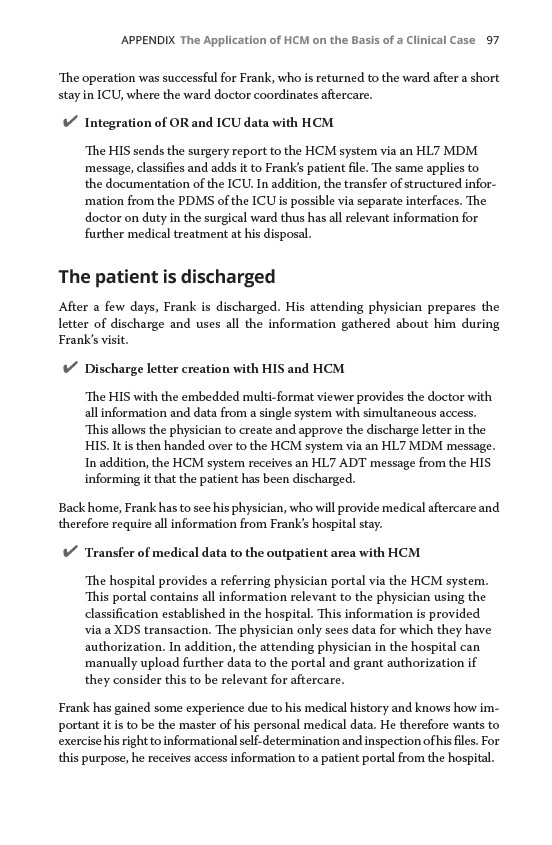
APPENDIX The Application of HCM on the Basis of a Clinical Case 97
The operation was successful for Frank, who is returned to the ward after a short
stay in ICU, where the ward doctor coordinates aftercare.
✔✔ Integration of OR and ICU data with HCM
The HIS sends the surgery report to the HCM system via an HL7 MDM
message, classifies and adds it to Frank’s patient file. The same applies to
the documentation of the ICU. In addition, the transfer of structured information
from the PDMS of the ICU is possible via separate interfaces. The
doctor on duty in the surgical ward thus has all relevant information for
further medical treatment at his disposal.
The patient is discharged
After a few days, Frank is discharged. His attending physician prepares the
letter of discharge and uses all the information gathered about him during
Frank’s visit.
✔✔Discharge letter creation with HIS and HCM
The HIS with the embedded multi-format viewer provides the doctor with
all information and data from a single system with simultaneous access.
This allows the physician to create and approve the discharge letter in the
HIS. It is then handed over to the HCM system via an HL7 MDM message.
In addition, the HCM system receives an HL7 ADT message from the HIS
informing it that the patient has been discharged.
Back home, Frank has to see his physician, who will provide medical aftercare and
therefore require all information from Frank’s hospital stay.
✔✔Transfer of medical data to the outpatient area with HCM
The hospital provides a referring physician portal via the HCM system.
This portal contains all information relevant to the physician using the
classification
established in the hospital. This information is provided
via a XDS transaction. The physician only sees data for which they have
authorization.
In addition, the attending physician in the hospital can
manually upload further data to the portal and grant authorization if
they consider this to be relevant for aftercare.
Frank has gained some experience due to his medical history and knows how important
it is to be the master of his personal medical data. He therefore wants to
exercise his right to informational self-determination and inspection of his files. For
this purpose, he receives access information to a patient portal from the hospital.